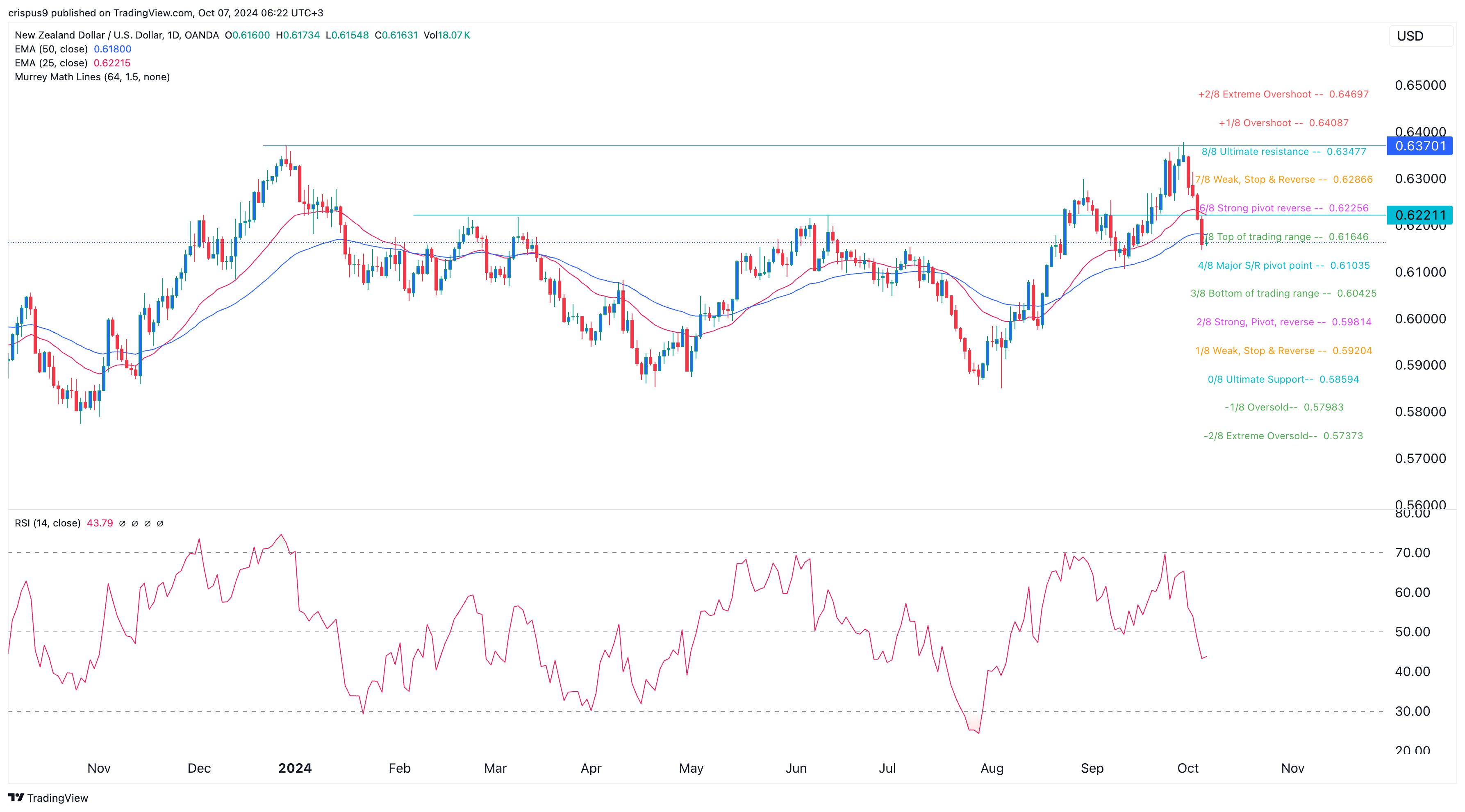
The NZD/USD exchange rate suffered a harsh reversal after the strong US jobs numbers and as traders positioned for this week’s Reserve Bank of New Zealand (RBNZ) interest rate decision. It slipped by over 3.5% from its highest point this year to the current 0.6165.
RBNZ interest rate decision
The RBNZ will be one of the few central banks that will deliver their interest rate decisions this week. The rest will be banks from South Korea and India.
Economists believe that the bank will deliver a big interest rate cut since the country’s inflation has moved downwards since 2022. It peaked at 7.3% in the second quarter of 2022, and has dropped in each of the next consecutive quarters.
The most recent data showed that the headline CPI fell from 4.0% in Q1 to 3.3% in the secons quarter. The CPI figure was lower than the median estimate of 3.5%.
Analysts believe that the upcoming CPI data will show that inflation dropped below 3% for the first time in months.
At the same time, there are signs that New Zealand’s economy was slowing. Recent data showed that the country’s unemployment rate rose from 4.3% to 4.6% in the second quarter.
Wage growth has also slowed while the recent GDP data showed that the economy contracted by 0.2% in the last quarter.
Therefore, analysts believe that the RBNZ will decide to cut interest rates by 0.50%, especially now that other banks have started their cutting interest rates. In a note, ING analysts said:
“We expect a 50bp cut to 4.75% at the October meeting, which is in line with consensus, but more dovish than the RBNZ projections, which included 50bp of total easing in 4Q24 (the next meeting is in November).”
Strong US dollar
The NZD/USD exchange rate continued falling because of the strong US dollar as geopolitical issues rise and as hopes of a more aggressive Fed fade.
The US dollar index (DXY), which measures the strength of the USD against a basket of currencies, rose for six consecutive days, reaching a high of $102.50, its highest point since August 2024. It has jumped by over 2.3% from its lowest point this year.
The USD is being driven by the rush to safety as geopolitical issues in the Middle East continue. Analysts expect that Israel will attack Iran’s energy infrastructure soon to retaliate against last week’s bombing campaign.
Attacking Iran’s key infrastructure will likely lead to more violence in the region, which will lead to higher oil prices and inflation. Recent data shows that the price of Brent and West Texas Intermediate (WTI) rose to over $75.
Looking ahead, the next key NZD/USD catalyst will be the Federal Reserve minutes and the US inflation data.
These minutes will provide more information about the deliberations that happened in the last meeting when the bank decided to cut rates by 0.50%
Economists expect the upcoming data to show that the headline Consumer Price Index (CPI) retreated from 2.5% in August to 2.3% in September. Core inflation, which excludes the volatile food and energy prices is expected to drop from 3.2% to 3.0%.
These numbers, while important, will not have a big impact on the Federal Reserve, which is mostly focusing on the labor market.
Data released last week shows that the unemployment rate slipped to 4.1% while the economy created more jobs than expected.
Therefore, analysts expect that the Fed will go slow on interest rate cuts, with Larry Summers arguing that the bank should embrace a wait-and-see attitude. Other analysts expect the bank to cut rates in smaller increments. In a note, ING analysts said:
“For now we continue to expect 25bp rate cuts through to next summer with the Fed funds bottoming at around 3.25-3.5%, whereas the market has it dropping to just below 3%.”
NZD/USD technical analysis

NZD/USD chart by TradingView
The daily chart shows that the NZD to USD exchange rate peaked at 0.6370 last month and then suffered a harsh reversal to the current 0.6165. It has dropped to its lowest point since September 16.
The pair has dropped below the 50-day and 25-day Exponential Moving Averages (EMA) while the Relative Strength Index (RSI) has moved below the neutral point at 50. Other oscillators like the MACD and the Stochastic Oscillator have all pointed downwards.
The pair has moved to the top of the trading range of the Murrey Math lines tool. Also, the pair has dropped below the key support at 0.6220, its June and February highs.
Therefore, the NZD/USD pair will likely continue falling as sellers target the next key support at 0.6100. The stop-loss of this trade will be at 0.6221.
The post NZD/USD suffers a harsh reversal ahead of RBNZ rate decision appeared first on Invezz
https://invezz.com/news/2024/10/06/nzd-usd-suffers-a-harsh-reversal-ahead-of-rbnz-rate-decision/


